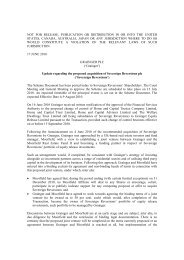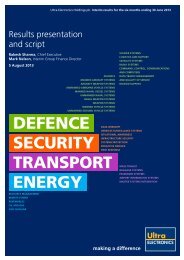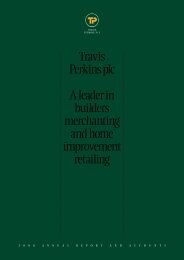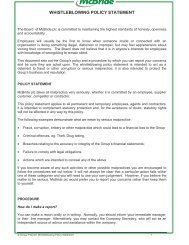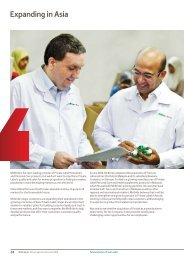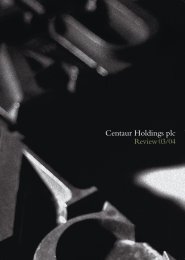Annual Report and Accounts - Hemscott IR
Annual Report and Accounts - Hemscott IR
Annual Report and Accounts - Hemscott IR
You also want an ePaper? Increase the reach of your titles
YUMPU automatically turns print PDFs into web optimized ePapers that Google loves.
TRAVIS PERKINS ANNUAL REPORT AND ACCOUNTS 2012<br />
Notes to the Financial Statements<br />
FOR THE YEAR ENDED 31 December 2012<br />
1. General information<br />
Overview<br />
Travis Perkins plc is a company incorporated in the United Kingdom<br />
under the Companies Act 2006. The address of the registered office is<br />
given on page 137. The nature of the Group’s operations <strong>and</strong> its principal<br />
activities are set out in the Chief Executive’s review of the year, the<br />
Deputy Chief Executive’s review of the year <strong>and</strong> the Finance Director’s<br />
review of the year on pages 38 to 43.<br />
These financial statements are presented in pounds sterling, the<br />
currency of the primary economic environment in which the Group<br />
operates.<br />
Basis of accounting<br />
The financial statements have been prepared in accordance with<br />
International Financial <strong>Report</strong>ing St<strong>and</strong>ards (‘IFRS’) issued by the<br />
International Accounting St<strong>and</strong>ards Board. The financial statements have<br />
also been prepared in accordance with IFRS adopted by the European<br />
Union <strong>and</strong> therefore the Group financial statements comply with Article 4<br />
of the EU IAS Regulations.<br />
Basis of preparation<br />
The financial statements have been prepared on the historic cost basis,<br />
except that derivative financial instruments are stated at their fair value.<br />
The consolidated financial statements include the accounts of the<br />
Company <strong>and</strong> all entities controlled by the Company (its subsidiaries)<br />
(together referred to as ‘the Group’) from the date control commences<br />
until the date that control ceases. Control is achieved where the Company<br />
has the power to govern the financial <strong>and</strong> operating policies of an<br />
investee entity to obtain benefits from its activities. As such, the results<br />
of subsidiaries acquired during the year are included in the consolidated<br />
income statement from the effective date of acquisition.<br />
In the current financial year, the Group has adopted the following,<br />
which did not have a material impact:<br />
• IAS 1 amendments Presentation of financial statements<br />
At the date of authorisation of these financial statements, the following<br />
St<strong>and</strong>ards <strong>and</strong> Interpretations, which have not yet been applied in these<br />
financial statements, were in issue, but not yet effective:<br />
• IAS 19 (revised) Employee benefits;<br />
• IAS 27 (revised) Separate Financial Statements;<br />
• IAS 28 (revised)Investments in Associates <strong>and</strong> Joint Ventures (2011);<br />
• IAS 32 (amended) Offsetting Financial Assets <strong>and</strong> Liabilities;<br />
• IFRS 9 Financial Instruments (2009);<br />
• IFRS 10 Consolidated Financial Statements;<br />
• IFRS 11 Joint Arrangements;<br />
• IFRS 12 Disclosure of Interests in Other Entities;<br />
• IFRS 13 Fair Value Measurement.<br />
The Directors anticipate that adoption of these St<strong>and</strong>ards <strong>and</strong><br />
Interpretations in future periods will have no material impact on the<br />
financial statements of the Group except as follows:<br />
As the Group has always recognised actuarial gains <strong>and</strong> losses<br />
immediately, there will be no effect on the defined benefit obligation of all<br />
defined benefit schemes <strong>and</strong> consequently no effect on the balance sheet<br />
disclosures. IAS 19 revised requires interest cost <strong>and</strong> return on scheme<br />
assets calculated under the previous version of IAS 19 to be replaced with<br />
a net interest amount calculated by applying a discount rate to the net<br />
defined liability or asset. The impact of this revision on profit before tax in<br />
2012 would be to lower profit before tax by approximately £12m.<br />
Management is currently of the opinion that the Group’s forecasts<br />
<strong>and</strong> projections, show that the Group should be able to operate within<br />
its current facilities <strong>and</strong> comply with its banking covenants. The Group<br />
is, however, exposed to a number of significant risks <strong>and</strong> uncertainties,<br />
which could affect the Group’s ability to meet management’s forecast <strong>and</strong><br />
projections <strong>and</strong> hence its ability to meet its banking covenants.<br />
The Directors believe that the Group has the flexibility to react to<br />
changing market conditions <strong>and</strong> is adequately placed to manage its<br />
business risks successfully despite the current uncertain economic<br />
outlook <strong>and</strong> challenging macro economic conditions.<br />
A detailed consideration of going concern, risks <strong>and</strong> uncertainties is<br />
provided in the Finance Director’s review of the year on pages 38 to 43.<br />
After making enquiries, the Directors have formed a judgement at the<br />
time of approving the financial statements, that there is a reasonable<br />
expectation that the Company <strong>and</strong> the Group have adequate resources<br />
to continue in operational existence for the foreseeable future. For this<br />
reason, they continue to adopt the going concern basis in preparing the<br />
financial statements.<br />
2. Significant accounting policies<br />
The principal accounting policies adopted in preparing the financial<br />
statements are set out below.<br />
Revenue recognition<br />
Revenue is recognised when goods or services are received by the<br />
customer <strong>and</strong> the risks <strong>and</strong> rewards of ownership have passed to them.<br />
Revenue is measured at the fair value of consideration received or<br />
receivable <strong>and</strong> represents amounts receivable for goods <strong>and</strong> services<br />
provided in the normal course of business, net of discounts <strong>and</strong> value<br />
added tax. For the Parent Company, revenue comprises management<br />
charges receivable <strong>and</strong> dividend income received.<br />
Exceptional items<br />
Exceptional items are those items of income <strong>and</strong> expenditure that<br />
by reference to the Group are material in size or unusual in nature or<br />
incidence, that in the judgement of the Directors, should be disclosed<br />
separately on the face of the financial statements (or in the notes in<br />
the case of a segment) to ensure both that the reader has a proper<br />
underst<strong>and</strong>ing of the Group’s financial performance <strong>and</strong> that there is<br />
comparability of financial performance between periods.<br />
Items of income or expense that are considered by the Directors<br />
for designation as exceptional items include, but are not limited to,<br />
significant restructurings, onerous contracts, write-downs or impairments<br />
of current <strong>and</strong> non-current assets, the costs of acquiring <strong>and</strong> integrating<br />
businesses, gains or losses on disposals of businesses <strong>and</strong> investments,<br />
re-measurement gains or losses arising from changes in the fair value of<br />
derivative financial instruments to the extent that hedge accounting is<br />
not achieved or is not effective <strong>and</strong> pension scheme curtailment gains.<br />
Business combinations <strong>and</strong> goodwill<br />
All business combinations are accounted for using the acquisition<br />
method. The cost of an acquisition represents the cash value of the<br />
consideration <strong>and</strong>/or the fair value of the shares issued on the date the<br />
offer became unconditional. The acquiree’s identifiable assets, liabilities<br />
<strong>and</strong> contingent liabilities that meet the conditions for recognition under<br />
IFRS 3 (2008) are recognised at their fair value at the acquisition date<br />
except that:<br />
• Deferred tax assets or liabilities <strong>and</strong> liabilities or assets related to<br />
employee benefit arrangements are recognised <strong>and</strong> measured in<br />
accordance with IAS 12 Income Taxes <strong>and</strong> IAS 19 Employee Benefits<br />
respectively;<br />
• Liabilities or equity instruments related to the replacement by the<br />
Group of an acquiree’s share-based payment awards are measured in<br />
accordance with IFRS 2 Share-based Payment;<br />
FINANCIAL<br />
STATEMENTS<br />
89




